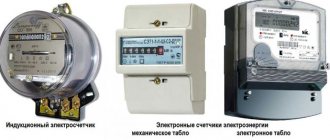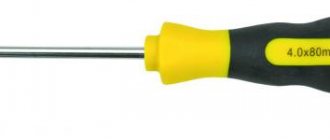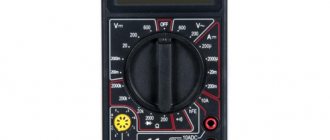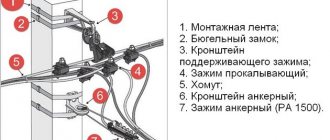Alexander Georgievich Kondratiev
An electrical engineer by training, he worked as an electronics engineer, chief engineer at a food company, and general director of a construction organization.
One of the problems in the relationship between owners in garage cooperatives is conflicts when paying for electricity. GSK pays for the electricity consumed by the society. Members of the cooperative pay the accountant directly for the quantity they consume.
The difference is divided equally among all members and paid separately or taken into account in membership fees. If electricity is stolen at GSK, then the other owners have to cover it, and no one likes this.
Strict accounting can be a way out of this situation. To do this, each owner needs to install an electric meter in the garage.
Selection options
Before you buy an electric meter for your garage, you should understand a little about the features of the devices in question. To do this you need:
- Calculate the maximum current consumption. If you do not plan to install energy-intensive equipment, then a device with a power of 10-50A will be enough for you. Otherwise, the electrical appliance must withstand a load of 100A.
- Find out the total number of phases. For example, the installation of metal-cutting units requires three-phase power.
- Take into account the accuracy class of the device. Usually it is 1.5-2%. Otherwise, the measuring equipment will not be accepted for operation by the regulatory authorities.
- Determine the characteristics of the device. Its price depends on additional features.
- Focus on installation requirements. Not all meters can be mounted on a DIN rail.
- Check the presence of the passport, guarantee and seals. They must be undamaged.
IMPORTANT: Before installing electrical equipment with maximum power, you need to know the parameters of the supply network. Such information can be clarified in the services servicing GSK
How to choose the right one
The choice of an electric meter depends on the characteristics of the network operation:
- single-phase induction - suitable for low energy consumption, usually only for lighting and switching on low-power consumers;
- three-phase electronic - if you plan to use machines and a welding unit. Such a device, as a rule, must be connected via a transformer;
In the latter case, the owner has the opportunity to take into account consumption according to several tariff plans.
You should also consider the temperature range of the device based on operating conditions. It is important to correctly determine the current characteristics of the meter and the power of the machine when turned on. It also depends on the total power of the connected devices.
Types of meters
To account for electricity consumption in non-residential premises, the following types of power plants are mainly used:
- Induction (electromechanical). Relatively inexpensive. Can work at low temperatures. The disadvantage is that they may have measurement errors.
- Electronic. Allows you to control the electricity consumed with the smallest errors. Not all device models can operate at low temperatures.
IMPORTANT: Modern electronic meters support work with communication modules, which allows you to take readings remotely
Three-phase meter for garage
In a garage where welding units and machines are often used, it would be logical to purchase a three-phase meter.
As a rule, such options are used in conditions where the rated power is more than 15 kW. They have many functions and are widely used in household networks and in monitoring three-phase electric motors.
The difference between such a device and a single-phase one is that it is capable of functioning under conditions of consuming large amounts of energy
There are several types of three-phase meters:
- Single tariff . It is considered standard; it has only one tariff and cannot be chosen. Suitable for installation in garages and production facilities.
- Two-tariff (multi-tariff). At night, the price per 1 kW of energy is significantly lower. This is beneficial for those who carry out activities in the garage at night, which significantly reduces electricity costs.
Three-phase meters come in two types:
- Electronic. The devices have a modern digital display.
- Mechanical. They include a screen with an arrow that shows the number of kW consumed.
The operating efficiency of both devices is at the same level. The differences may be in appearance or additional options, such as a remote control, but such models will cost significantly more.
Making a wiring diagram
To properly create a wiring diagram, make a list of electrical appliances that you plan to use in the garage. The number of lamps and their location must be taken into account.
If the garage is used only for parking and minor car repairs, then there is no need for a large number of sockets and lamps, but you also don’t need to save much. Above the workbench or near the entrance, you can install several sockets and a two-key switch so that you can divide the lighting lines into groups.
Article on the topic: Where to find a tuning garage in GTA San Andreas without completing missions
A multi-use garage should have good lighting and plenty of conveniently located outlets. It is also necessary to ensure safe lighting of the inspection pit.
Design features
Different types of meters differ in design. The mechanical device consists of two coils: one is current, and the second is supplied with voltage. Inside them there is a metal disk mounted in sliding bearings. A worm pair is mounted on its axis, which is connected to a mechanical counter. When the device operates, an electromagnetic field arises, which causes the disk to rotate, due to which the amount of electricity consumed is calculated.
In electronic devices there is no mechanical part at all. These devices convert analog signals into digital ones. For this purpose, special pulse sensors are used, which are connected to electricity using a transformer. The signal is sent to the microcontroller, which allows you to calculate the energy consumed. This data is displayed on a digital display. Such devices have a high accuracy class and allow the accumulation and transmission of information through special communication channels.
Three-phase meters have a similar device. The most popular devices are electronic ones. Some models support single-phase metering. They are reliable, integrate into automated accounting systems, and are small in size.
I asked an awkward question - the electricity was turned off. A controversial story from a garage cooperative
However, before this, it is necessary to request from the network provider a standard contract, an assignment for performing work with an act of division of balance sheet ownership. Meter installation process Often, electricity meter installation in apartments is carried out by representatives of the network company. First of all, in the process of installing and connecting the meter, follow the rules of the Electrical Installation Regulations, which describe all the main aspects. Important nuances First of all, before installing the meter, you need to check the state inspection period. The seal must bear the date of inspection.
Connection method and accounting type
When choosing an electric meter, consumers pay attention not only to the operating principle, but also to the connection method and the type of metering for energy consumption. Three-phase devices are connected directly or indirectly.
The installation diagram is quite simple:
- When consuming a small amount of energy, install the device directly into the break in the supply wires.
- In the case of using powerful consumers, an indirect connection is used using intermediate transformers.
The type of device metering plays an important role in saving money if you use three-phase meters. During operation of such a device, active and reactive energy is consumed. If financial accounting is carried out with a single-phase electrical appliance, the active part is calculated. And when a multiphase unit operates, electricity is first consumed, then it is returned through the network. Energy metering can save money.
Purchasing consumables
Having drawn up a diagram, purchase everything you need to complete the work. We will do this thoroughly and for a long time, so we will consider installing hidden wiring. To be fair, there are other ways to run wires in the garage, which you can read about here.
In order not to waste precious time and effort in vain, purchase or rent a wall chaser and a hammer drill with a set of drills and a concrete bit, the diameter of which will allow you to install socket boxes and distribution boxes in the holes cut with it. We won’t even talk about a chisel and a hammer, since such a tool should be in any garage.
Article on the topic: What is a garage in slang
For further work you will need:
- Distribution panel – 1 pc.
- Electricity meter – 1 pc. (if needed).
- RCD – 1 pc.
- Socket boxes - according to the number of mortise switches and sockets.
- Distribution boxes - in each place where there will be a outlet for sockets and switches.
- Automatic switches - type and quantity according to the diagram. It may be necessary to install some machines separately, for example, near a grinding machine, compressor, etc.
- Wiring. It is better to purchase a copper three-core wire. For lighting - 1.5 mm2. For sockets - 2.5 mm2. For wiring in the garage to the panel - 4 mm2. Quantity - according to the scheme + 10% for unaccounted terminals in distribution boxes and socket boxes. In order to power more powerful consumers, it is recommended to run a separate wiring line from the distribution panel to the desired location.
- Corrugated PVC pipes for electrical wiring. The diameter and quantity are selected to match the existing wiring. If the wiring will pass through flammable materials, then a metal corrugated pipe should be laid in such places.
- If there is a point in the garage for connecting 380V electrical equipment, then you need to take care of purchasing a specific outlet and the appropriate cable.
- Sockets. Their number should be sufficient for convenient use. It is important to remember that there can be several lamps above the workbench - they can be connected either through junction boxes or directly into sockets.
- Switch. Someone prefers to turn off the lighting in the garage with one switch, another likes to divide it into several groups, and a third installs a switch under each lamp - everyone can do it in a way that is convenient for them to use.
You can make a distribution panel yourself, like the author of this video:
Preparatory stage before installation
When the device has already been purchased, the question arises about its installation. Before connecting, you need to undergo appropriate training. And follow the algorithm of actions:
- Installation of boxing. It includes two parts, the first is the internal part, which has two slats and a zero bus, and the second is the outer element in the form of a protective cover with a door. Attached to the wall at a height of approximately 0.8-1.7 meters from the ground. The box must be securely fastened.
- Installation of modular elements. To increase the level of safety, a special circuit breaker is installed in front of the device. This will prevent fire or short circuit under heavy load. The next step is the installation of sockets and a step-down transformer, to which portable lighting is connected for work in the basement or pit.
- Connecting the meter. Typically, the manufacturer indicates the connection diagram on the back cover of the device. The phase wire is connected to terminal 1, and the neutral wire to terminal 3.
- Connecting contacts. Each contact must be carefully installed, since after installing the seals there will be no access to them.
- Circuit breakers. You need to connect the supply wires through the top row of contacts, and the outgoing wires through the bottom.
- We connect the device and protective equipment. The load is connected to terminal 2 (phase) and terminal 3 (zero). Be sure to check the reliability of the fastened contacts.
IMPORTANT: Before carrying out installation work, make sure that the electricity is turned off. To do this, use a voltage indicator. If you are not confident in your abilities and do not understand the topic and features of working with the electrical network, be sure to contact a specialist
What to include in the diagram?
Any garage must have an RCD (residual current device) installed. Although this device is not cheap, it will protect the owner from electric shock. The rated current of the RCD must be selected in accordance with the load current of the electrical wiring line, otherwise the device may not operate at the right time.
Also, you should not save on purchasing circuit breakers - it is better that each line is connected separately. Of course, it is necessary to take into account the total power of the connected devices so that the cross-section of the wire to be laid can be calculated.
Simple scheme
Often, owners of garages used only for car storage are limited to installing a paired circuit breaker at the entrance, one or two sockets and several lamps, which are controlled by a single-key switch. This scheme has its advantages: to pick up a car from the garage or put it there, you just need to turn on one switch, and the light will be on throughout the entire room.
One socket is connected directly to the machines, the second is included in the same circuit with the lamps. When leaving the garage, you can be sure that when you turn off the lights, you have cut off the power to the distant outlet. Even if the garage owner accidentally forgets to turn off the charger, it will turn off along with the light. The simplicity of the design implies some limitations. So, all 4 lamps will turn on at the same time, and the second socket is only suitable for powering low-power devices through it, otherwise the switch contacts will burn out.
Electrical wiring diagram for a garage with an inspection hole
Now let's look at the electrical circuit of a garage with an inspection pit. There are 5 lines coming from the input electrical panel:
- Socket group 1.
- Socket group 2.
- Lighting group 1.
- Lighting group 2.
- Lighting of the inspection pit.
The electrical panel contains an input circuit breaker, an RCD and several circuit breakers - each for its own group. As for the lighting of the inspection pit, it is carried out through a transformer that reduces the voltage to 12 or 36V.
Video: wiring diagrams
On the Internet you can find photos of a wide variety of electrical wiring diagrams in the garage.
Installation Features
Installing the meter is relatively easy. Be sure to follow safety precautions and carefully check the circuit and connections. If the wires are not securely fastened, they may begin to spark. But if the owner does not have experience in installation work, and he doubts his abilities, in this case it is worth contacting a specialist.
The PUE permits independent installation of the switchboard with the installation of a meter. In this case, a mandatory requirement is to call a specialist who will check the connection diagram and seal the device
Electrical wiring in the garage: connection options, wiring diagrams, installation
Even the simplest garage needs lighting, but if the wiring is done in a hurry, it would be unreasonable to expect it to be reliable and fireproof. When creating proper working conditions in this room, one must not neglect the rules for working with electrical wiring, otherwise the consequences can be the most unpredictable. In this article we will tell you how to do electrical wiring in the garage with your own hands, adhering to the standards and regulations.
Among the shortcomings
Some models of electricity meters may have their drawbacks. These include:
- The blinking does not coincide with the clicks, which will mislead the user.
- Problems with telemetry.
- Poor build quality.
- Display without backlight.
- A short period of time for verification.
- Poor performance at low temperatures.
- High price.
- Lack of protection from moisture.
Yes, for some minor nuances do not matter much, but still, it is better to study the subject from all sides.
Installation
It is quite possible to install electrical wiring in a garage with your own hands, as you will now see.
So, the diagram is there, the tools and materials are prepared - you can start working.
- We will mark the walls in the places where the wiring will pass, and switches, sockets and distribution boxes will be installed. It is important to remember that laying the wire obliquely is undesirable. Then, if you need to fix something on the wall, it will be difficult to determine where the wire runs in the wall - it is better to make all the bends at right angles.
- After marking the walls, check the diagram again to make sure nothing is missing.
- Drive the car into the garage and check if the sockets and lights are conveniently located. If not, then mark the places where it would be better to install them. Will a light mounted on the ceiling or wall adequately illuminate the engine so that the oil level can be checked.
- Now the car is not needed, and it is better if it is located outside the garage.
- All holes for distribution boxes and socket boxes are made using a suitable size crown.
- According to the applied markings, the grooves are cut out, then the excess building material is removed using a hammer drill according to the depth of the cut. The result should be a groove in which the corrugated pipe intended for it will hide.
Article on the topic: Which foundation for a garage to choose?
Now you can carry out electrical wiring in the garage, with step-by-step instructions to help. Let’s immediately make a reservation that professionals first lay the corrugation in the wall, install the socket boxes, and then tighten the cable. But if this is the first time you are laying electrical wiring in a garage with your own hands, then it is better to adhere to the technology we propose.
- Having bent the end of the wire protruding from the corrugation, the corrugation itself is placed in the groove so that it fits into the socket boxes.
- The marked piece of corrugation is cut off, and the end of the wire is bent so that it does not fall inside.
- Then the wire is threaded into the corrugation so that there are free ends on both sides - 15 centimeters each. You can learn more about this process by watching the video.
- The corrugation with the wire is placed in the groove and covered with alabaster. Similar actions are performed with the remaining wire.
- Then the wire along with the corrugation is inserted into the sockets/distribution boxes, and only after that they are installed and secured with alabaster. In those places where lamps will be installed on the wall, the wire is simply routed out.
- After installing the input panel, the wires are connected to the machines. To make it easier to navigate and not confuse anything, each wire must be labeled, indicating what it is intended for in this circuit.
When wiring in a garage is done by a non-specialist, problems often arise with connecting the RCD. A selection of two videos will help you avoid mistakes when connecting this device.
- After connecting the wires, it is advisable to check again whether everything is assembled correctly in the panel.
- Now you can turn on the introductory machine, then the RCD and all the machines in turn.
- If the installation is done correctly, then all connection points should work.
As you can see, even a non-professional can cope with this work. If, after reading this, you still continue to doubt your abilities and your palms begin to sweat at the mere thought of working with electricity, then it’s better to invite a specialist.
Which model should you give preference to?
Above we told you what models generally exist, now we will only talk about which one is better to choose, buy for an apartment, garage, cottage, private house. Find out how a three-tariff meter works.
First of all, you must clearly rely on the characteristics of each meter, and the main thing is its power. If you don't get it right, then installing it may be pointless. You can find all the characteristics in his book.
To count everything, use the simplest way:
- Look at all the electrical appliances in your home, they are marked with wattage ratings, don't forget that you also have lamps.
- We add all the power together.
- If you get 10 kW, then a 60A meter is enough for you.
- If more, then choose a 100A meter.
The calculation is quite simple, but remember, all equipment needs to be counted. If you have a controversial issue, always round up; it is better to overpay once again than to choose the wrong electric meter for your home.
Also look at its functionality, whether it’s one tariff or two. If you need a meter for your dacha, then don’t even think about it, take one tariff, there will be no mistakes here. But in a private house or apartment, this issue should be approached carefully, because meters for several tariffs are not always profitable. There are a lot of controversial issues here that should be taken into account.
Multi-tariff electricity meter
The main parameter from the point of view of savings is the number of tariffs included in the electricity meter for an apartment; there are single-tariff, double-tariff or multi-tariff electricity meters. Let's take a closer look at the two-tariff system, where the day rate is from 7:00 to 23:00 and the night rate is from 23:00 to 7:00.
As an example, consider electricity tariffs in Moscow in 2014.
The table shows that the night tariff T-2 is 75% lower than the day T-1 tariff, so if, for example, of your monthly 200 kWh, the night tariff T-2 accounts for half of the electricity consumed, then the price for electricity will be equal to:
C=Wday*T-1 + Wnight*T-2 = 100*4.53 + 100*1.16 = 569 rubles
With a single-rate tariff, when the price for electricity is the same at all hours of the day:
C=W*T = 200 * 4.50 = 900 rubles
The difference was 331 rubles, and in a year it will already be 4,000 rubles. Your multi-tariff electricity meter for an apartment or house will pay for itself in almost 1 month, and in the future you will actually save on electricity bills. And if you have your own home with a consumption of not 200 kWh per month, but 2,000 kWh (electric heating, electric heated floors, you turn on the washing machine only at night), then the savings with a multi-tariff electric meter will be much more significant.
But......not everything is the same for everyone when it comes to paying for electricity with two-tariff electricity meters, let’s take another region - the Kursk region:
In the Kursk region, the price for electricity, if the electric meter also “winds up” 200 kWh, will be at the “day-night” tariff equal to:
C = 100*3.22 + 100*2.41 = 563 rubles
And with a single-rate tariff:
C = 200 * 3.05 = 610 rubles
The difference with a two-tariff electric meter for an apartment or house is no longer so significant, and this is taking into account the electricity consumption day and night 50/50. And if in a private house this can be achieved quite realistically - by increasing the power of the house’s electric heating or heated floors at night, and reducing it during the day, then in an apartment, consumption during the day in most cases will be 80 percent, and this will lead to the fact that at the “day-night” tariff you will pay more than at the single-rate rate. But if the difference in the price of an electric meter of 600-800 rubles is not significant for you, then purchase a multi-tariff electric meter for an apartment or house. In case of constant overpayment at the day-night tariff, you can always switch to a single tariff by writing the appropriate paper to the energy supply, if you pay for electricity directly to them, or to your management company.
In my opinion, the transition to a multi-tariff regime, first of all, depends on a person’s lifestyle; if a person constantly wakes up at 7 am and goes to bed until 11 pm, then the transition to multi-tariff accounting is absolutely not necessary for him. You can turn on the washing machine after 11 pm, when you are already asleep, but you do not control the process, and one water leak in the washing machine, if you have to re-do the repairs for your neighbors and yourself, will “eat up” all the savings from the “nightly” tariff for many years .
Additional parameters of the electric meter
I will briefly describe the various additional parameters and functions of electricity meters. Electricity meters differ according to the principle of operation: electronic and induction. Many people mistakenly believe that if the electric meter for an apartment is electronic, then it is obviously more accurate than an induction one, but this is not so. If an electric meter has the same accuracy class (error), for example 1%, then these electric meters will count the same with an error of up to 1%.
Currently, there are many additional characteristics and options for an electric meter for an apartment or house - this includes displaying various information on the display (date-time, electrical network parameters, power value, electricity growth per month, year, etc.), storing values electricity for several months, electronic passwords, remote connection and reading of electricity meter readings via digital interfaces, GSM modem, using an optical port, and much more.
It is clear that the more sophisticated the electric meter for an apartment or house is, the more expensive it is. Leading manufacturers of electricity meters have a fairly large selection, from the simplest induction electricity meters for several hundred rubles, to electronic ones with all sorts of bells and whistles for several tens of thousands of rubles.
Also, when choosing an electric meter, pay attention that the electric meter for the apartment is included in the State Register of Measuring Instruments of Russia (State Register), i.e. an electricity meter for an apartment must be “approved” by Russian standards in the field of metrology
Each measuring instrument that meets Russian standards is entered into the register under its own unique number.
Box for metering device
Given the nature of the operation of the electric meter, it is important to ensure its reliable protection. This is ensured by using a special box. Such boxes are marked as follows, depending on the variety:
- Control room is the simplest model,
In addition to the meter itself, a circuit breaker, grounding and neutral busbars can be placed inside the box.
The box may have the following design:
- floor;
- built-in;
- waybill (hinged);
- hidden or open;
- whole or dismountable.
The choice should be determined by the type of device and the designed installation design. To do this, the owner must use the help of appropriate specialists.











